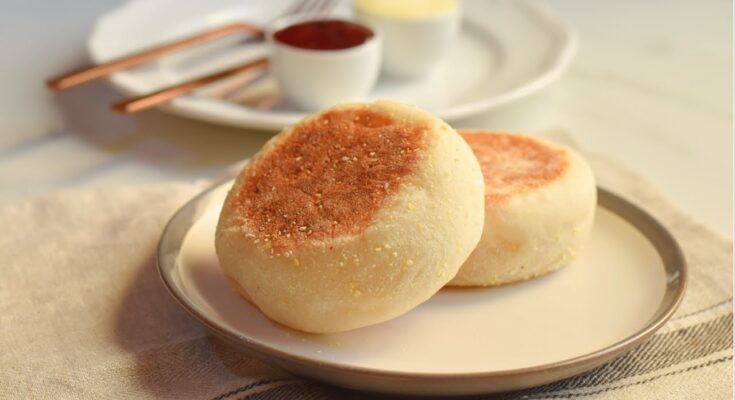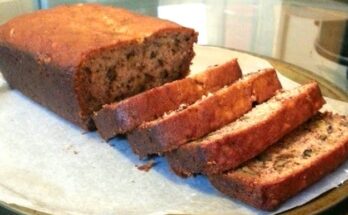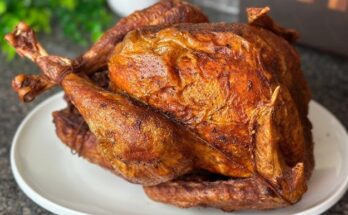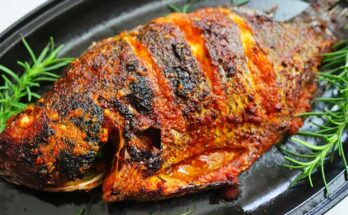English Muffin Bread Recipe: There’s something magical about the aroma of freshly baked bread filling the kitchen. Among all bread recipes, English Muffin Bread stands out as a perfect balance between simplicity and taste. Unlike traditional loaves, this bread has that signature airy texture with nooks and crannies, making it the ultimate companion for butter, jam, or even a savory sandwich.
What makes this bread so special is its versatility—it toasts beautifully, pairs well with both sweet and savory toppings, and is easier to make than most artisan-style breads. If you’ve ever craved the classic flavor of English muffins but wanted a simpler baking process, this loaf is your answer.
This step-by-step guide will walk you through everything: the ingredients you’ll need, essential tools, and each baking stage in detail. By the end, you’ll have a golden, perfectly textured loaf ready to slice, toast, and enjoy.
Ingredients You’ll Need
To make the perfect loaf of English Muffin Bread, you’ll need a combination of pantry staples and a few baking essentials. The beauty of this recipe lies in its simplicity—no complicated ingredients or fancy flours required.
Essential Ingredients for Perfect Texture
- All-purpose flour – the base that gives the bread structure.
- Warm milk – activates the yeast and adds richness.
- Warm water – helps create the right dough consistency.
- Active dry yeast – ensures a light and airy loaf.
- Granulated sugar – feeds the yeast and adds a touch of sweetness.
- Salt – balances flavors and strengthens the dough.
- Baking soda – helps achieve the signature nooks and crannies.
- Butter or oil – adds moisture and softness to the bread.
Optional Add-ins for Extra Flavor
- Shredded cheese for a savory loaf.
- Herbs like rosemary, thyme, or basil.
- Dried fruits such as raisins or cranberries.
- Seeds like sunflower, sesame, or flax for extra crunch.
Ingredient Substitutions and Alternatives
- Use plant-based milk instead of dairy for a vegan version.
- Swap whole wheat flour for part of the all-purpose flour for a healthier loaf.
- Substitute honey or maple syrup for sugar for natural sweetness.
With just these few ingredients, you’ll be ready to create a loaf that tastes bakery-fresh but comes straight from your home oven.
Tools and Equipment Required
One of the best parts of this recipe is how little equipment it requires. You don’t need a bread machine or complicated baking tools.
Basic Baking Tools
- Mixing bowls (large and medium)
- Measuring cups and spoons
- Wooden spoon or spatula
- Loaf pan (standard 9×5 inch)
- Kitchen towel or plastic wrap (for covering dough)
Special Tools That Make Baking Easier
- Stand mixer with a dough hook (optional, but speeds up mixing)
- Instant-read thermometer (to check liquid temperature for yeast)
- Cooling rack (to let the loaf cool evenly)
- Serrated bread knife (for clean slicing)
Even if you’re a beginner baker, these basic tools are all you need to succeed.
Step-by-Step Guide to Making English Muffin Bread
Now for the fun part—the actual baking process! Making English Muffin Bread is much simpler than traditional bread recipes. You don’t need to knead the dough for long, and it requires minimal handling. Let’s go through it step by step.
Step 1: Preparing the Ingredients
Start by gathering all your ingredients and ensuring your milk and water are warmed to about 110°F (warm but not hot). This temperature is perfect for activating yeast without killing it. Measure everything precisely to avoid dry or overly sticky dough.
Step 2: Mixing the Dough
In a large mixing bowl, combine warm milk, water, sugar, and yeast. Let it sit for 5–10 minutes until the mixture becomes foamy, which means the yeast is active. Add the flour, salt, baking soda, and melted butter. Stir with a wooden spoon or mix with a stand mixer until the dough comes together. It should be sticky but manageable.
Step 3: First Rise and Resting
Cover the bowl with a kitchen towel and let the dough rest in a warm place for about 45 minutes to 1 hour. During this time, the yeast works its magic, and the dough should double in size. This rise is crucial for creating the light texture of English Muffin Bread.
Step 4: Shaping and Pan Preparation
Once your dough has doubled in size, it’s time to get it ready for baking. Lightly grease a standard 9×5-inch loaf pan with butter or non-stick spray. You can also sprinkle the pan with cornmeal to give the bread that authentic English muffin texture.
Punch down the risen dough gently to release excess air. Unlike traditional bread dough, you don’t need to knead this one heavily. Simply scoop it into the loaf pan, spreading it evenly with a spatula or your hands. Don’t worry if the dough looks a little sticky—this is what gives English Muffin Bread its classic airy crumb and open texture.
Sprinkle a light dusting of cornmeal on top if you’d like to add extra crunch. At this stage, your dough is ready for its second rise, which will help it take shape before hitting the oven.
Step 5: Second Rise for Fluffiness
Cover the pan loosely with plastic wrap or a kitchen towel and set it aside in a warm spot. Allow the dough to rise again for about 30–45 minutes, or until it reaches just above the rim of the loaf pan.
This second rise is what transforms the dough from dense and heavy to fluffy and soft. If your kitchen is cool, you can place the pan inside an unheated oven with just the light on—it creates the perfect environment for rising.
Keep an eye on the dough during this stage. Over-proofing can cause the bread to collapse, while under-proofing can lead to a dense loaf. Aim for a pillowy rise that holds its shape when gently touched.
Step 6: Baking to Golden Perfection
Preheat your oven to 375°F (190°C) while the dough is finishing its rise. Once ready, place the loaf pan in the center rack and bake for 30–35 minutes, or until the top is golden brown and the bread sounds hollow when tapped.
For an extra-crisp crust, you can brush the top with melted butter during the last 5 minutes of baking. Once baked, remove the bread from the oven and allow it to cool in the pan for 5 minutes. Then transfer it to a wire rack to cool completely before slicing.
This cooling step is very important—if you cut the bread too soon, the inside may turn gummy. Patience pays off here, leaving you with a perfectly textured loaf that slices like a dream.
Tips for the Perfect English Muffin Bread
Even though this recipe is beginner-friendly, a few small details can make the difference between a good loaf and a bakery-quality one.
How to Get the Signature Nooks and Crannies
The hallmark of English muffin bread is those little air pockets that soak up butter and jam. To achieve them:
- Keep the dough sticky rather than dry—don’t over-flour it.
- Allow both rises to happen fully.
- Don’t over-knead; gentle mixing is best.
Common Mistakes and How to Avoid Them
- Dense bread: Usually caused by expired yeast or under-proofing.
- Collapsed loaf: This happens when the dough rises too long in the second stage. Keep an eye on it.
- Dry texture: Often from using too much flour. Remember, slightly sticky dough is ideal.
Following these tips ensures your loaf turns out soft, airy, and loaded with character every single time.
Serving Suggestions
One of the best parts of English Muffin Bread is how versatile it is. Freshly baked, toasted, or even repurposed into other recipes, it never disappoints.
Breakfast Ideas
- Toasted slices with butter and jam.
- A base for eggs Benedict.
- Smeared with cream cheese and fresh fruit.
Pairing with Savory Dishes
- Use as sandwich bread for turkey, ham, or grilled cheese.
- Toast alongside soups and stews.
- Top with avocado, smoked salmon, or scrambled eggs.
Creative Toasting Options
- Cinnamon sugar toast for a sweet snack.
- Garlic butter toast for a savory side.
- French toast made with thick slices for a weekend treat.
This bread is as versatile as it gets, and it shines whether you keep it simple or dress it up for something fancy.
Storage and Freezing Guide
Homemade bread is always best enjoyed fresh, but luckily, English Muffin Bread stores well and freezes beautifully. Knowing the right way to keep it will help you extend its freshness without sacrificing texture or flavor.
How to Store at Room Temperature
After your loaf has cooled completely, store it in a bread box, paper bag, or wrapped loosely in plastic wrap. Avoid airtight containers, as they can trap moisture and make the crust soggy. At room temperature, your bread should stay fresh for 3 to 4 days.
If you plan to toast slices, pre-slicing the bread before storing makes things quicker and easier. Just grab a slice, pop it in the toaster, and enjoy warm bread anytime.
Freezing for Long-Term Storage
For longer storage, freezing is your best option. Here’s how:
- Slice the cooled bread into portions.
- Wrap slices tightly in plastic wrap or parchment paper.
- Place them in a freezer-safe bag, squeezing out excess air.
- Label with the date to track freshness.
Frozen English Muffin Bread lasts up to 3 months. When ready to eat, simply toast a frozen slice directly—no need to thaw. This method keeps it tasting as fresh as the day you baked it.
Variations of English Muffin Bread
The beauty of this recipe is that it’s a great base for experimenting. With a few tweaks, you can create exciting new flavors and textures.
Whole Wheat Version
Swap half of the all-purpose flour for whole wheat flour. This gives the bread a nuttier flavor and boosts fiber content while still keeping it light and fluffy.
Cheese and Herb English Muffin Bread
Mix shredded cheddar or mozzarella into the dough and sprinkle in dried herbs like rosemary, oregano, or thyme. The result? A savory loaf perfect for sandwiches or soup dipping.
Sweet Cinnamon Raisin Twist
For a sweeter option, add cinnamon and raisins to the dough. This variation makes a delicious breakfast bread that tastes amazing toasted with butter or cream cheese.
Each variation keeps the same easy method but lets you enjoy a new flavor every time you bake.
Nutritional Information
Homemade bread doesn’t just taste better—it’s often healthier than store-bought versions since you control the ingredients.
Calories and Macros per Slice (approximate, based on a standard loaf sliced into 12 pieces):
- Calories: 130
- Carbohydrates: 24g
- Protein: 4g
- Fat: 2g
- Fiber: 1g
Health Benefits of Homemade Bread
- No preservatives or additives – just simple ingredients.
- Lower in sodium and sugar than many commercial breads.
- Customizable – you can make it healthier with whole grains, seeds, or plant-based milk.
By baking at home, you not only enjoy fresh, warm bread but also take control of your nutrition.
Troubleshooting Your Bread
Even with the easiest recipes, things don’t always go as planned. If your loaf didn’t turn out perfect, here’s how to fix it next time.
Why Your Bread Didn’t Rise
- Yeast was expired or killed by hot liquid.
- Dough was placed in a drafty or cold spot.
- The first rise wasn’t given enough time.
Fixing a Dense or Gummy Texture
- Add slightly less flour next time if the dough was too stiff.
- Make sure to let the bread cool fully before slicing—cutting too early traps steam and makes it gummy.
- Ensure the oven was preheated properly for even baking.
With a little practice, these issues become easy to avoid, and each loaf will turn out better than the last.
FAQs about English Muffin Bread Recipe
1. Can I Make This Recipe Without a Mixer?
Absolutely! A sturdy wooden spoon and some elbow grease are all you need. The dough is sticky, but since it doesn’t require heavy kneading, it’s very manageable.
2. Can I Use Gluten-Free Flour?
Yes, but use a 1:1 gluten-free baking flour blend for the best results. The texture may be slightly different, but it will still be delicious.
3. How Long Does Homemade English Muffin Bread Last?
Stored at room temperature, about 3 to 4 days. In the freezer, up to 3 months.
4. Can I Double the Recipe?
Yes! Just divide the dough into two loaf pans. Make sure each pan has enough room for proper rising.
5. What’s the Best Way to Toast It?
Slice it thick, toast until golden, and top with butter, jam, or your favorite spread. The nooks and crannies soak everything up beautifully.
Conclusion
English Muffin Bread is the perfect combination of simplicity and flavor. With just a handful of ingredients and minimal effort, you can bake a loaf that rivals bakery quality. Whether you enjoy it toasted with jam for breakfast, layered into a savory sandwich, or flavored with herbs and cheese, this bread is bound to become a staple in your kitchen.
If you’ve been intimidated by bread baking before, this recipe is the perfect place to start. Follow the steps, trust the process, and in no time, you’ll have a golden, airy loaf ready to enjoy.



